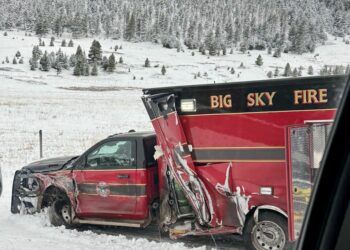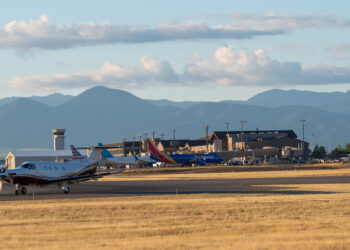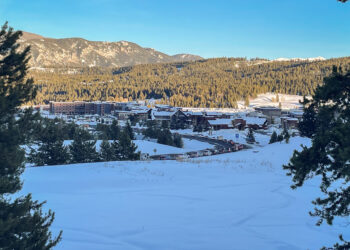By Gabrielle Gasser EBS STAFF
BIG SKY – Big Sky Resort opens in six days. Before getting out there to shred on Thanksgiving Day, it’s important to make sure your equipment is properly tuned up and ready to go.
There are several shops in big sky that offer ski tuning services. Explore Big Sky went behind the scenes at Grizzly Outfitters in Big Sky Town Center to get the inside scoop on their tuning process and recommendations for gear maintenance.
Before you even have to pay for a tune, Grizzly Outfitters is happy to offer free assessments of your gear so you can decide how you want to proceed.
It is best to be proactive and get your gear prepped early, if possible. The Grizzly Outfitters ski and snowboard repair shop opened on Nov. 1 after a shoulder season closure and once winter operations are in full swing, they will offer their overnight tuning and repair service.
After early November, business will likely increase for ski shops, especially around holidays, so as a savvy local, it’s a good idea to get your skis to the shop as soon as possible.
EBS talked with Colin Leo-Nyquist, the repair manager at Grizzly Outfitters, and got all of our pre-season prep questions answered.
Gabrielle Gasser: What should people be doing to prep their equipment for the season?
Colin Leo-Nyquist: “The easiest way is to bring it to us, of course. But at the most basic level, waxing your skis is incredibly important… That’s something I recommend be done at least once a year. Another important thing is we always recommend having your bindings calibrated and checked every year.”
GG: What is your advice for summer ski storage?
CL-N: “A lot of it is more where you store your skis so a lot of people will throw their skis in a basement or a shed. And that’s just really bad, the edges, get really rusty, and sometimes they get so rusty, that base will start to kind of [de-laminate] away from that rusty edge there.”
GG: Where should you store your skis?
CL-N: “Ideally a temperature-controlled area, somewhere that doesn’t get too wet and somewhere that doesn’t get too cold, either. “
GG: Should everyone be getting their skis tuned?
CL-N: “I mean of course I’d love everyone get their skis tuned. We’re not going to push an excessive amount of service, but you can’t over wax the ski.”
GG: Walk me through what you are repairing when you tune a ski?
CL-N: “So, we’re just kind of first just checking out the ski, not just this condition you know…base damage and edging, but also for any kind of more serious repair we want to catch that right off the bat. … We’re looking for blown sidewalls, blown edges, delamination on the base anywhere, and then again, the overall condition of that base.”
GG: How often should people tune their skis throughout the season?
CL-N: “It really depends on you know how much they’re abusing them. I wax my skis every other time I use them pretty much, I also run a ski shop.”
After we sat down and discussed the importance of ski tunes and why everyone should get them, Leo-Nyquist took me behind the scenes and showed me the process of tuning a ski. In the ski shop at Grizzly there’s a giant machine from Switzerland that automates many of the steps. According to Leo-Nyquist, Grizzly Outfitters was the first shop in the country to get the Crystal Rock ski tuning machine produced by the ski service technology company MONTANA which is based in Switzerland. While the machine is efficient and allows them to tune more skis, Leo-Nyquist explained that robots can never replace a good hand tune. He said they still complete high-end race tunes, which are done by hand, and have no machine equivalent. Here are the steps that Leo-Nyquist walked me through for a standard ski tune.
Ski Tune Steps:
- Initial P-tex work: The first step is to lay down some sintered polyethylene or P-tex to fill in any damage to the base.
- Initial belting: The belt is akin to a wet sander and is rougher than the stone. It takes off more material and preps the ski for the stone grind.
- Stone grind: The stone takes off less material than the belt and gets the ski flat and level making it easier to set the base bevel.
- Set the side bevel: For a standard tune, the side bevel is set at a one- or two-degree angle. A three-degree side bevel would be appropriate for race skis.
- Blank the ski: This step is to get a smooth, bank canvas before adding structure.
- Final structuring pass and base edge: The structure is specific to conditions. In Big Sky, a finer structure is added to the ski that is tighter and doesn’t go as deep.
- Detune the ski: A gummy stone is used to knock down any burrs and make a cleaner edge that will stay sharper for longer.
- Wax the ski: Grizzly uses an infrared waxer for a more controlled and even heat which opens up the ski pores, so the wax is absorbed.
- Remove excess wax and buff: After waxing the ski, it is passed over a buffing wheel to remove excess wax and buff the base.













